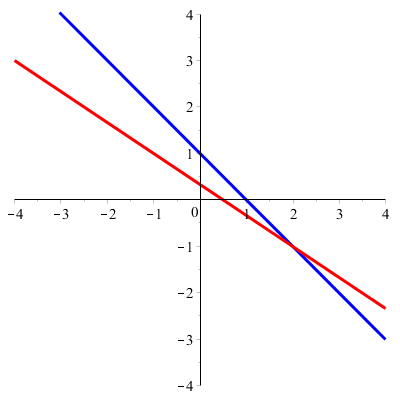Systems of linear equations and matrices: Systems of Linear Equations
 Lines in the plane
Lines in the plane
One of the many ways of describing a straight line in the flat plane is a linear equation. We discuss how to use linear equations for determining an equation for the line through two points looks and for determining the points of intersection of two lines.
An equation for a line in the flat plane
Let \(a\), \(b\), and \(c\) be fixed real numbers. The solution of the equation \(a\cdot x+b\cdot y+c=0\) can be drawn in the plane. If at least one of #a#, #b# is distinct from #0#, then the solution points form a straight line, for short, a line.
- If \(b\ne0\), then we can write the equation as \(y=-\frac{a}{b}x-\frac{c}{b}\). After all, these are the solutions if we view \(x\) as a parameter and \(y\) as an unknown. It indicates that, for each value of \(x\), there is a point \(\rv{x,y}\) with \(y\) equal to \(-\frac{a}{b}x-\frac{c}{b}\).
- If \(a \ne 0\), then we have an inclined line.
- If \(a=0\), then the value of \(y\) is always equal to \(-\frac{c}{b}\), and, we have a horizontal line.
- In the exceptional case \(b=0\), the equation looks like \(a\cdot x+c=0\).
- If \(a \ne 0\), then we have a vertical line.
- If \(a=0\) and
- \(c\ne 0\), then there are no solutions;
- \(c=0\), then every value \(x\) and every value for \(y\) is a solution.
Not only the lines themselves are solutions of linear equations, also determining intersections of lines and finding a line through two points can be reduced to solving linear equations:
Operations with lines in the plane
- The detection of points of intersection of two lines is equivalent to finding the solutions of the system of equations for the corresponding lines.
- An equation for the line through two distinct points #\rv{p,q}# and #\rv{r,s}# can be found by finding a solution distinct from #\rv{0,0,0}#of the system of equations \[\eqs{a\cdot p+b\cdot q+c&=&0\\ a\cdot r+b\cdot s+c&=&0}\] in the unknowns #a#, #b#, #c#.
Below are examples of these two operations.
The lines intersect at the point #\rv{2,-1}#
By subtracting twice the first equation from the second, the equation \(y+1=0\) arises. It implies #y=-1#. Substituting this value for #y# in the first equation gives #2x-4=0# , from which it follows that #x=2#. Thus, the solution of the system is #x=2\land y= -1#. This means that #\rv{x,y} = \rv{2,-1}# is the point of intersection of the two lines.
In the figure below, the first line is drawn in red and the second is drawn in blue.


Or visit omptest.org if jou are taking an OMPT exam.



